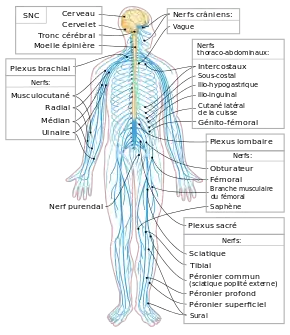Neuropathie sensitive disséminée de Wartenberg
La neuropathie sensitive disséminée de Wartenberg (NSDW) encore appelée dans les pays anglo-saxons « neuropathie sensitive migrante de Wartenberg » (Wartenberg's Migratory Sensory Neuropathy) est une affection rare, décrite en 1958 par Robert Wartenberg. Cette maladie peut être facilement confondue avec la sclérose en plaques ou le syndrome de Guillain-Barré. Il s'agit cependant d'une affection bénigne évoluant par poussées et rémissions. Elle se manifeste par une douleur névralgique suivie d'une perte de sensibilité dans le territoire de distribution d'un nerf cutané sensitif, déclenchées par un mouvement d'étirement d'un membre qui peut être d'amplitude modérée[1]. La douleur, les dysesthésies et la sensation d'engourdissement ont une durée très variable, de quelques secondes à plusieurs semaines. Dans certains cas la douleur est au second plan[2].
Texte anglais à traduire :
Only a few case studies have ever been reported[3], and even of Wartenbergs own patients only 2 of the 9 conform strictly to his own description of the clinical characteristics; however there are a couple of surprising case clusters of this condition in both the Thames Valley and San Francisco[4].
Cause
Whilst the actual cause of this polyneuropathy remains unknown, most research now puts this as an immune-mediated, chronic, asymmetric polyneuropathy[5] - [6]. Stress may also be a contributory factor. This condition also causes demyelination caused by an error in the actual enzyme that creates immunoglobulin.
Symptoms
Positive Tinel's sign is often present[7]. Any cutaneous sensory nerve can be involved with patients usually showing a slow start, building up to sensations in many parts of the body[8]. At times, the focal nerve lesions can be painful. Most symptoms resolve but permanent sensory loss can persist. Electrodiagnostic studies demonstrate axon loss in the distribution of the involved cutaneous nerves. Patients sometimes described a sensation of electric discharge when elongating nerve trunks. In half of the cases the attacks of dysesthesia or of sensory loss followed one another within less than one year. The deficits were fully reversible in a third of the cases studied by Rev Neurol (Paris) after a mean total evolution of 4 to 8 years[7].
Mean onset age, 35 years with a range of 4th and 5th decades[9].
Pure sensory mononeuritis multiplex
Course: Episodic; Recurrent Some sensory loss improves, Other is permanent
Sensory loss: Discrete areas: Involvement of individual cutaneous nerves Sudden onset Distribution: Legs; Arms; Trunk; Face
Pain: In areas of sensory loss Painful dysesthesias: Induced by limb stretch or movement
Electrodiagnostic: Multifocal axon loss Pathology: Biopsy of affected nerve Perineurial scarring Chronic inflammation Axonal loss & regeneration: Differential fascicular involvement Endoneurial edema Immunoglobulin deposition
Treatments
Due to the unknown cause of this condition, treatment seems to be symptomatic and individual to the patient. Steroid treatments such as prednisone don't seem to work[10] but there is anecdotal evidence for the use of amitriptylene, and either pregabalin or gabapentin[11] along with a variety of painkillers. This is often treated similarly to diabetic neuropathic pain, but diabetes is not necessarily present.
Some sufferers have responded well to the drug lyrica, which is a common name for the pregabalin referred to above, but others report side effects.
Wartenbergs Syndrome
Despite some confusion, WMSN is different to Wartenbergs Syndrome - a Radial sensory nerve entrapment causing significant pain in the lower 1/3rd of the forearm[12].

Notes et références
- (en) Matthews WB, Esiri M, « The migrant sensory neuritis of Wartenberg », J Neurol Neurosurg Psychiatr., vol. 46, no 1, , p. 1–4 (PMID 6842194, PMCID 1027254).
- « http://www.elsevier-international.com/e-books/viewbook.cfm?ID=942 »(Archive.org • Wikiwix • Archive.is • Google • Que faire ?) (consulté le ).
- (en) Zifko UA, Hahn AF, « Migrant sensory neuropathy: report of 5 cases and review of the literature », J Peripher Nerv Syst., vol. 2, no 3, , p. 244–9 (PMID 10975730).
- (en) Hudgson P, « The migrant sensory neuritis of Wartenberg », Br Med J (Clin Res Ed), vol. 287, no 6394, , p. 704 (PMID 6412790, PMCID 1549075).
- http://www.avondalemedical.com/pdf_files/PNMar2005/PN0305FeaNeuropathy.pdf
- (en) Nicolle MW, Barron JR, Watson BV, Hammond RR, Miller TA, « Wartenberg's migrant sensory neuritis », Muscle Nerve, vol. 24, no 3, , p. 438–43 (PMID 11353434, DOI 10.1002/1097-4598(200103)24:3<438::AID-MUS1020>3.0.CO;2-Y).
- Laterre C, Ghilain S, Tassin S, Guérit JM, « [Wartenberg's disseminated sensory neuropathy] », Rev Neurol. (Paris), vol. 144, no 5, , p. 358–64 (PMID 2843980).
- (ja) Hamano T, Kaji R, Oka N, Akiguchi I, Kimura J, « [Migrant sensory neuritis—electrophysiological and pathological study] », Rinsho Shinkeigaku, vol. 32, no 10, , p. 1112–6 (PMID 1297555).
- « Asymmetric Neuropathies », sur wustl.edu (consulté le ).
- (en) Nicolle MW, Barron JR, Watson BV, Hammond RR, Miller TA, « Wartenberg's migrant sensory neuritis », Muscle Nerve, vol. 24, no 3, , p. 438–43 (PMID 11353434, <438::AID-MUS1020>3.0.CO;2-Y lire en ligne).
- http://www.partialobserver.com/Wartenberg.cfm#id35
- http://www.whonamedit.com/synd.cfm/1979.html Who Named it? website